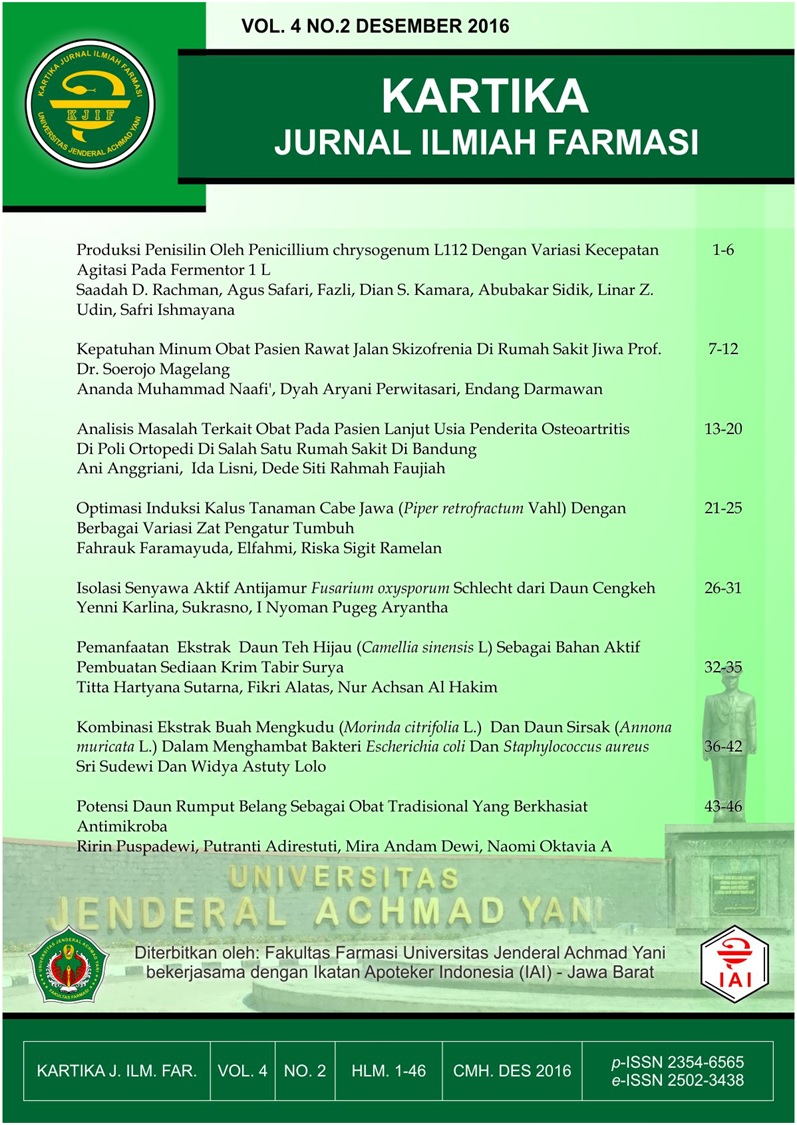POTENSI DAUN RUMPUT BELANG SEBAGAI OBAT TRADISIONAL YANG BERKHASIAT ANTIMIKROBA
DOI:
https://doi.org/10.26874/kjif.v4i2.66Abstrak
ABSTRAK
Â
Telah dilakukan penelitian tentang pengujian ekstrak etanol dari daun rumput belang terhadap pertumbuhan Staphylococcus aureus, Escherichia coli dan Shigella dysenteriae. Rumput belang (Zebrina pendula Schnizl.) merupakan tanaman hias yang budidayanya sangat mudah sehingga tanaman ini dapat ditemukan didataran rendah maupun dataran tinggi. Secara empiris memiliki rumput belang memiliki khasiat antara lain untuk mengatasi disentri dan bisul. Hasil pengujian ekstrak etanol 96 % terhadap Staphylococcus aureus memberikan hambatan terbesar pada konsentrasi 60% = 11,69±0,57 (mm), Escherichia coli memberikan hambatan terbesar pada konsentrasi 80% = 12,83±0,68 (mm), Shigella dysenteriae memberikan hambatan terbesar pada konsentrasi 80% = 12,81±0,43 (mm). Hasil pemeriksaan golongan kandungan kimia pada ekstrak daun rumput belang terdapat flavonoid, polifenol, kuinon, monoterpenoid-seskuiterpenoid dan senyawa steroid-triterpenoid.
Â
Â
Kata kunci  : daun rumput belang, Staphylococcus aureus, Escherichia coli dan Shigella dysenteriae
Â
ABSTRACT
Â
A research on the testing of the ethanol extract of the leaves of rumput belang on the growth of Staphylococcus aureus, Escherichia coli and Shigella dysenteriae. Striped grass (Zebrina pendula Schnizl.) Is an ornamental plant cultivation is very easy so that the plant can be found in lowland and highland. Empirically the leaves of rumput belang have properties among others, to overcome dysentery and ulcers. Results of testing the 96% ethanol extract against Staphylococcus aureus provide the biggest obstacle at a concentration of 60% = 11.69 ± 0.57 (mm), Escherichia coli provide the biggest obstacle at a concentration of 80% = 12.83 ± 0.68 (mm), Shigella dysenteriae provide the biggest obstacle at a concentration of 80% = 12.81 ± 0.43 (mm). Class examination results of chemical constituents in the leaves of rumput belang extracts are flavonoids, polyphenols, quinones, monoterpenoid-sesquiterpenoids and steroid-triterpenoid compounds.
Â
Keywords : the leaves of rumput belang, Staphylococcus aureus, Escherichia coli and Shigella dysenteriae
Referensi
Agra M, Franca P, Jose M. 2007 Synopsis of the Plants known as Medicinal and Poisonous in Northeast of Brazil. Universitas Federal de Paraiba. Journal of Pharmacognosy., hal 126
Cetto A, Heinrich M. Mexican Plants with Hypoglycaemic Effect Used in the Treatment of Diabetes. 2005 Department of biology cellular, Faculty of Science, Universitas Nasional Autonoma, Mexico. Journal of Ethnopharmacology. ; 99 : 335
Cates R. G., Prestwich, B., Innes, A., Rowe, M., Stanley M., Williams S., 2013, Evaluation of the activity of Guatemalan medicinal plants against cancer cell lines and microbes, AcademicJournals, Vol. 7 (35), pp.2616-2627. ISSN 1996-0875, http://www.academicjournals.org/Journal of Medical Plants Research.
Harborne, J.B . Metode Fitokimia, terjemahan Kosasih Padmawinata, Penerbit ITB, Bandung. 1987 : Hal 6-7
Hariana H. Arief, 2006, Tumbuhan Obat dan Khasiatnya Seri 3, Penebar Swadaya, Jakarta hal 12.
Hariyati T, Dyah D, Yayuk A. 2015. Pengaruh Ekstrak Etanol Daun Jambu Air (Syzygium aqueum) terhadap bakteri Isolat Klinis. Journal Pendidikan IPA. Mataram., Vol 1;No 2. Hal 34-35
Heineir, Michael, 2009. Farmakognosi dan Fitoterapi, Buku Kedokteran EGC. Jakarta.
Idaka E, Toshihiko O, Tadao K, and Toshio G. 1987. Isolation of Highly Acylated Anthocyanins from Commelinaceae Plants, Zebrina pendula, Rheo spathacea and Setcreasea purpurea. Department of Chemistry, Faculty of Engineering, Gifu University, Yanagido, Japan. 51 (8) : 2215-2220.
Lee B, Wei Jin Yap, Shen Yeng Tan, dkk. Antioxidant Content, Antioxidant Activity, and Antibacterial Activity of Five Plants from the Commelinaceae Family. School of Science, Monash University Sunway Campus, Malaysia. Article. 2014 ; 3 : 763
Madigan MT, Martinko JM, Dunlap PV, Clark DP. 2008. Biology of Microorganisms 12th edition. San Francisco: Pearson.
Murphy Marjorie C. 1999. Plant Products as Antimicrobial Agents. Clinical Microbiology Reviews. Vol.12, No. 4; Hal 565-568
Ncube, N.S., Afolayan, A.J. and Okoh, A.I. Assessment Techniques of Antimicrobial Properties of Natural Compounds of Plant Origin: Current Methods and Future Trends. African Journal of Biotechnology. 2008 ; 7 (12) : 1797-1806.
Pratiwi, S.T., 2002, Mikrobiologi Farmasi, Erlangga Medical Series, hal 188-191.
Prescott LM, Harley JP, Klein DA. 2002. Microbiology. 5th Ed. Boston: McGraw-Hill.
Radulovic, Blagojevic, Stojanovic R, N.M Stojanovic. 2012. Antimicrobial Plant Metabolites: Structural Diversity and Mechanism of Action. Article in current Medicinal Chemistry. Hal 939
Radulovic, Blagojevic, Stojanovic R, N.M Stojanovic. 2012. Antimicrobial Plant Metabolites: Structural Diversity and Mechanism of Action. Article in current Medicinal Chemistry. Hal 93
##submission.downloads##
Diterbitkan
Cara Mengutip
Terbitan
Bagian
Lisensi
Penulis yang menerbitkan artikel pada jurnal ini menyetujui ketentuan berikut:
- Penulis memberikan hak cipta dan jaminan atas artikel sebagai publikasi pertama, yang memberikan kesempatan pada orang lain untuk membagi artikel dibawah lisensi Creative Commons Attribution License
- Penulis dapat melakukan perubahan dan menambahkan untuk pendistribusian artikel yang terpublikasi secara non eksklusif (misalnya, mempostingnya ke repositori institusional atau mempublikasikannya dalam sebuah buku), dengan pengakuan publikasi awal dalam jurnal ini.
- Penulis diizinkan dan didorong untuk memposting pekerjaan mereka secara online (misalnya, di repositori institusional atau di situs web mereka) sebelum dan selama proses pengajuan, karena dapat mengarah pada pertukaran produktif, serta kutipan pekerjaan sebelumnya dan lebih besar yang diterbitkan (Lihat The Effect of Open Access).























